Abstract
Six strains of a new species, Legionella sainthelensi, were isolated from freshwater in areas affected by the volcanic eruptions of Mt. St. Helens in the state of Washington. Strains of L. sainthelensi are culturally and biochemically similar to other legionellae. They grow on buffered charcoal yeast agar but not on media that lack cysteine. They are gram-negative, nonsporeforming, motile rods that are positive in reactions for catalase, oxidase, gelatin liquefaction, and beta-lactamase. They are negative in reactions for urease, hydrolysis of hippurate, reduction of nitrates, fermentation of glucose, and blue-white autofluorescence. Their cell wall fatty acid composition is qualitatively similar to those of other legionellae, with 50 to 62% branched-chain fatty acids. They contain the isobranched-chain 14- and 16-carbon acids and anteisobranched-chain 15- and 17-carbon acids and relatively large amounts of straight-chain 16-carbon acid. All strains of L. sainthelensi contain approximately equal amounts of ubiquinones Q9, Q10, Q11, and Q12, a pattern similar to those of Legionella bozemanii, Legionella dumoffi, and Legionella longbeachae. Serological cross-reactions were observed between L. sainthelensi, both serogroups of L. longbeachae, and Legionella oakridgensis. Three strains of L. sainthelensi were greater than 90% related by DNA hybridization. The type strain of L. sainthelensi, Mt. St. Helens 4, was 36% related to the type strain of L. longbeachae and 3 to 14% related to the other nine described Legionella species.
Full text
PDF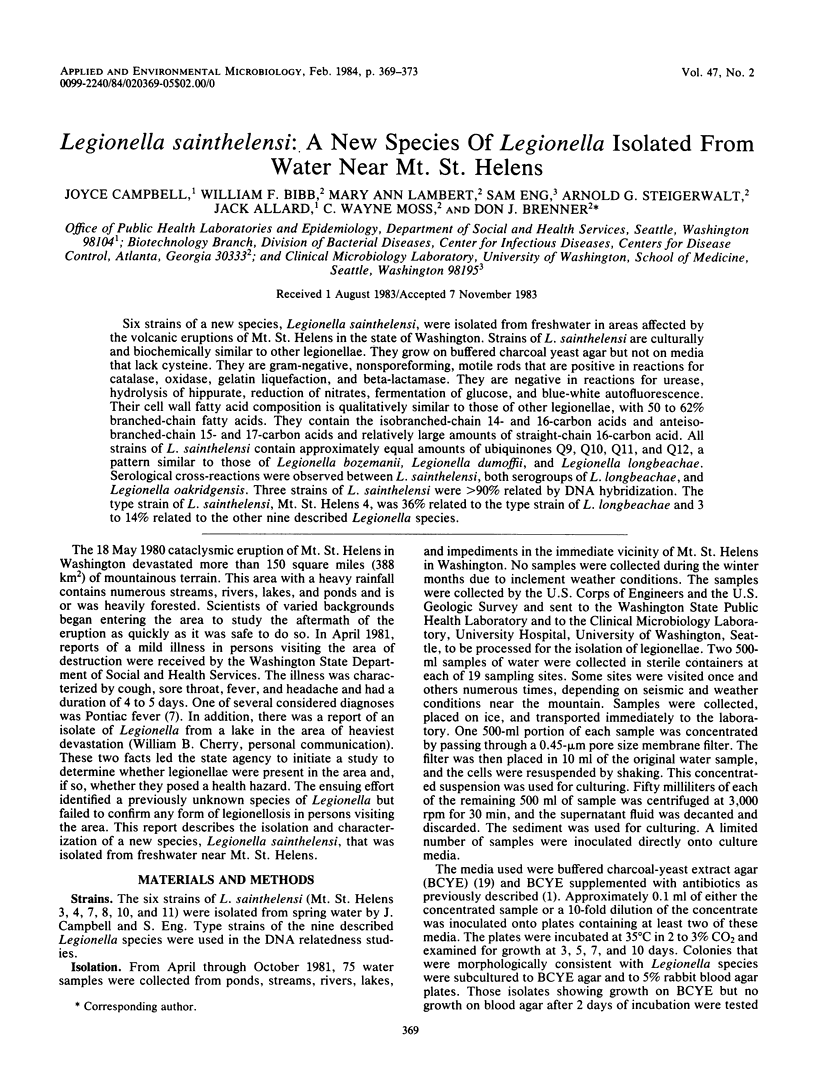
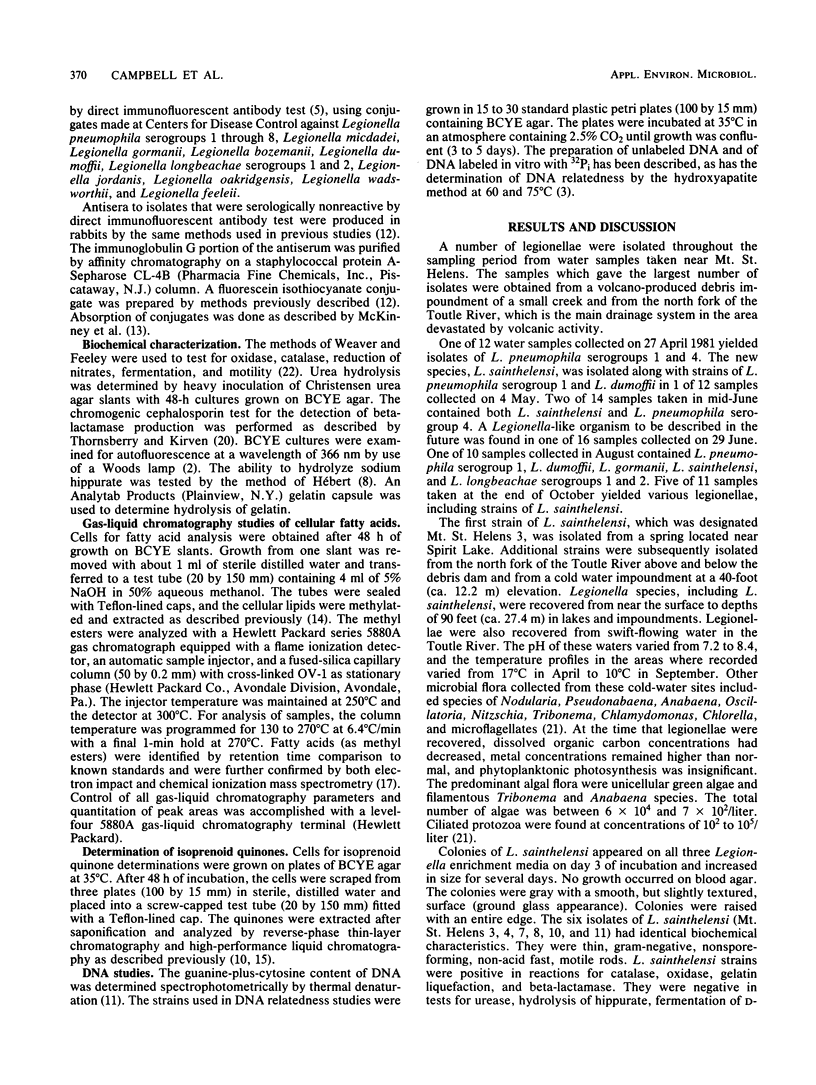
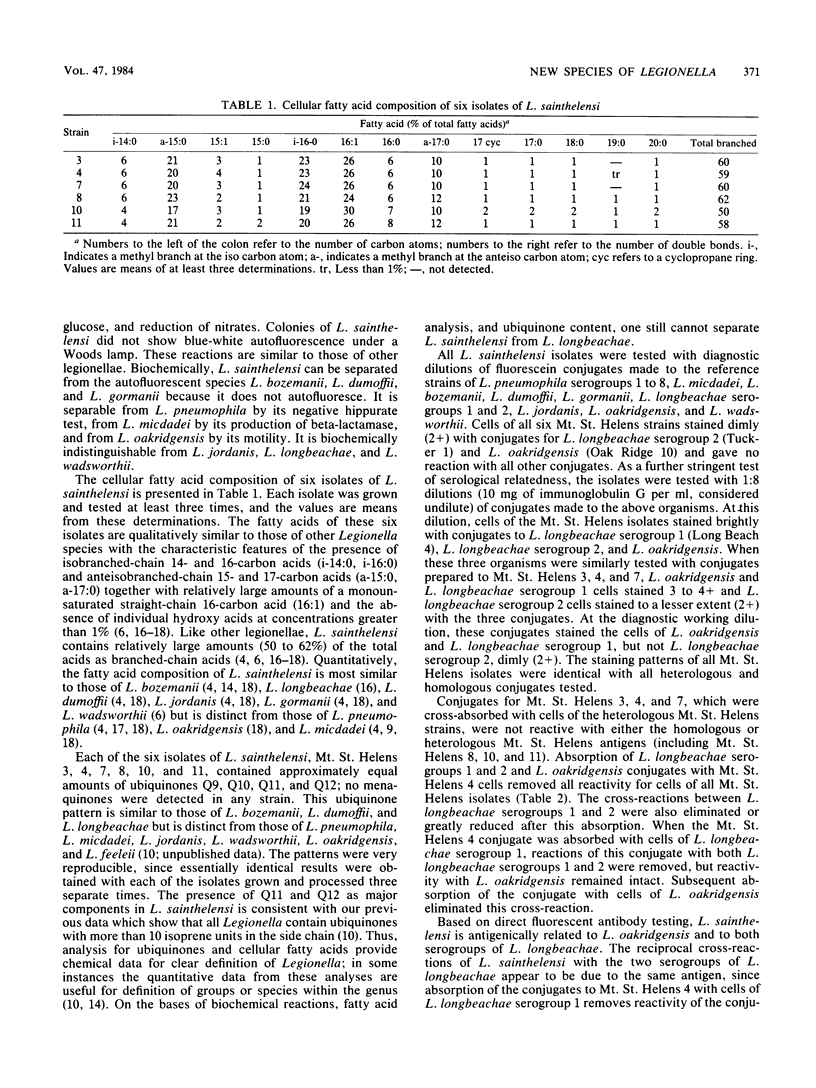
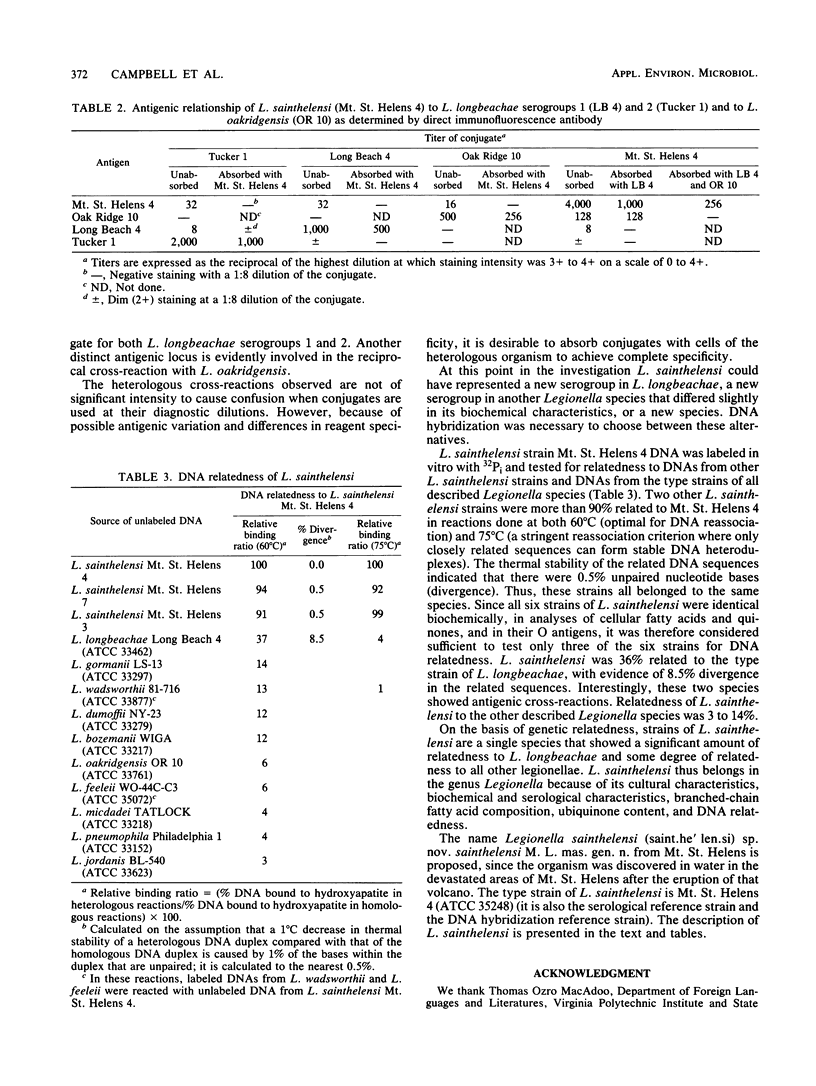
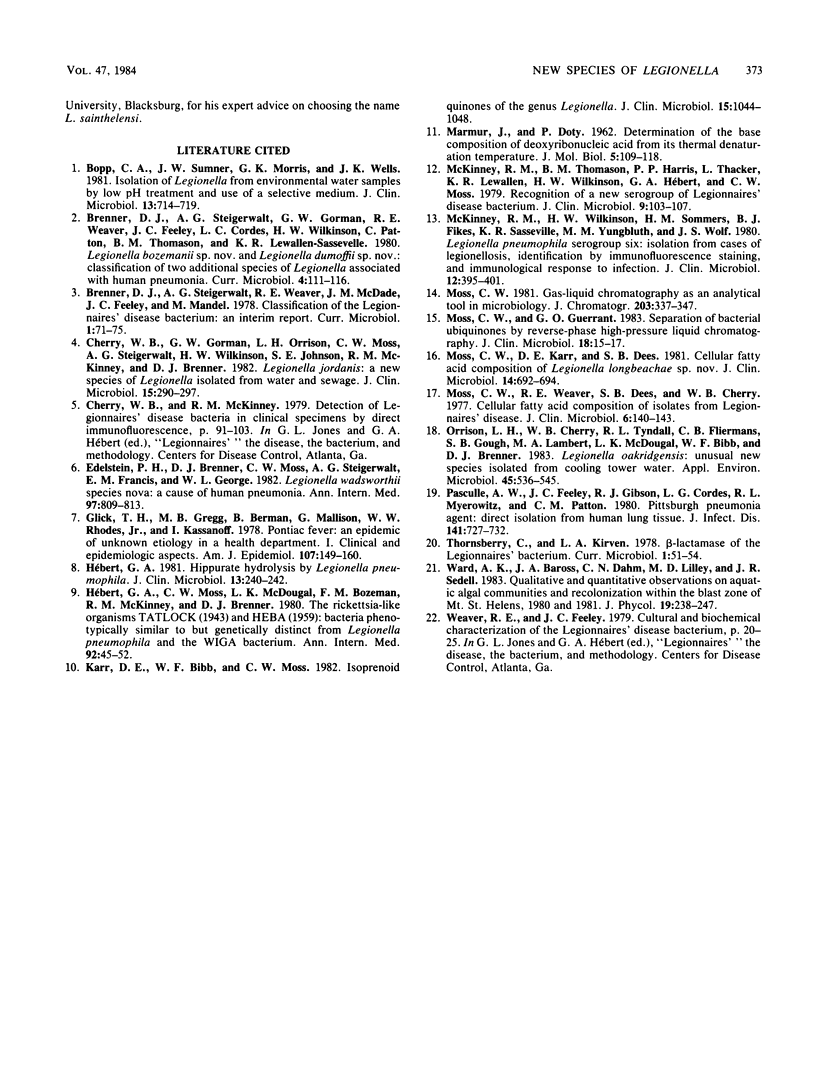
Selected References
These references are in PubMed. This may not be the complete list of references from this article.
- Bopp C. A., Sumner J. W., Morris G. K., Wells J. G. Isolation of Legionella spp. from environmental water samples by low-pH treatment and use of a selective medium. J Clin Microbiol. 1981 Apr;13(4):714–719. doi: 10.1128/jcm.13.4.714-719.1981. [DOI] [PMC free article] [PubMed] [Google Scholar]
- Cherry W. B., Gorman G. W., Orrison L. H., Moss C. W., Steigerwalt A. G., Wilkinson H. W., Johnson S. E., McKinney R. M., Brenner D. J. Legionella jordanis: a new species of Legionella isolated from water and sewage. J Clin Microbiol. 1982 Feb;15(2):290–297. doi: 10.1128/jcm.15.2.290-297.1982. [DOI] [PMC free article] [PubMed] [Google Scholar]
- Edelstein P. H., Brenner D. J., Moss C. W., Steigerwalt A. G., Francis E. M., George W. L. Legionella wadsworthii species nova: a cause of human pneumonia. Ann Intern Med. 1982 Dec;97(6):809–813. doi: 10.7326/0003-4819-97-6-809. [DOI] [PubMed] [Google Scholar]
- Glick T. H., Gregg M. B., Berman B., Mallison G., Rhodes W. W., Jr, Kassanoff I. Pontiac fever. An epidemic of unknown etiology in a health department: I. Clinical and epidemiologic aspects. Am J Epidemiol. 1978 Feb;107(2):149–160. doi: 10.1093/oxfordjournals.aje.a112517. [DOI] [PubMed] [Google Scholar]
- Hébert G. A. Hippurate hydrolysis by Legionella pneumophila. J Clin Microbiol. 1981 Jan;13(1):240–242. doi: 10.1128/jcm.13.1.240-242.1981. [DOI] [PMC free article] [PubMed] [Google Scholar]
- Hébert G. A., Moss C. W., McDougal L. K., Bozeman F. M., McKinney R. M., Brenner D. J. The rickettsia-like organisms TATLOCK (1943) and HEBA (1959): bacteria phenotypically similar to but genetically distinct from Legionella pneumophila and the WIGA bacterium. Ann Intern Med. 1980 Jan;92(1):45–52. doi: 10.7326/0003-4819-92-1-45. [DOI] [PubMed] [Google Scholar]
- Karr D. E., Bibb W. F., Moss C. W. Isoprenoid quinones of the genus Legionella. J Clin Microbiol. 1982 Jun;15(6):1044–1048. doi: 10.1128/jcm.15.6.1044-1048.1982. [DOI] [PMC free article] [PubMed] [Google Scholar]
- MARMUR J., DOTY P. Determination of the base composition of deoxyribonucleic acid from its thermal denaturation temperature. J Mol Biol. 1962 Jul;5:109–118. doi: 10.1016/s0022-2836(62)80066-7. [DOI] [PubMed] [Google Scholar]
- McKinney R. M., Thomason B. M., Harris P. P., Thacker L., Lewallen K. R., Wilkinson H. W., Hebert G. A., Moss C. W. Recognition of a new serogroup of Legionnaires disease bacterium. J Clin Microbiol. 1979 Jan;9(1):103–107. doi: 10.1128/jcm.9.1.103-107.1979. [DOI] [PMC free article] [PubMed] [Google Scholar]
- McKinney R. M., Wilkinson H. W., Sommers H. M., Fikes B. J., Sasseville K. R., Yungbluth M. M., Wolf J. S. Legionella pneumophila serogroup six: isolation from cases of legionellosis, identification by immunofluorescence staining, and immunological response to infection. J Clin Microbiol. 1980 Sep;12(3):395–401. doi: 10.1128/jcm.12.3.395-401.1980. [DOI] [PMC free article] [PubMed] [Google Scholar]
- Moss C. W. Gas-liquid chromatography as an analytical tool in microbiology. J Chromatogr. 1981 Jan 9;203:337–347. doi: 10.1016/s0021-9673(00)80305-2. [DOI] [PubMed] [Google Scholar]
- Moss C. W., Guerrant G. O. Separation of bacterial ubiquinones by reverse-phase high-pressure liquid chromatography. J Clin Microbiol. 1983 Jul;18(1):15–17. doi: 10.1128/jcm.18.1.15-17.1983. [DOI] [PMC free article] [PubMed] [Google Scholar]
- Moss C. W., Karr D. E., Dees S. B. Cellular fatty acid composition of Legionella longbeachae sp. nov. J Clin Microbiol. 1981 Dec;14(6):692–694. doi: 10.1128/jcm.14.6.692-694.1981. [DOI] [PMC free article] [PubMed] [Google Scholar]
- Moss C. W., Weaver R. E., Dees S. B., Cherry W. B. Cellular fatty acid composition of isolates from Legionnaires disease. J Clin Microbiol. 1977 Aug;6(2):140–143. doi: 10.1128/jcm.6.2.140-143.1977. [DOI] [PMC free article] [PubMed] [Google Scholar]
- Orrison L. H., Cherry W. B., Tyndall R. L., Fliermans C. B., Gough S. B., Lambert M. A., McDougal L. K., Bibb W. F., Brenner D. J. Legionella oakridgensis: unusual new species isolated from cooling tower water. Appl Environ Microbiol. 1983 Feb;45(2):536–545. doi: 10.1128/aem.45.2.536-545.1983. [DOI] [PMC free article] [PubMed] [Google Scholar]
- Pasculle A. W., Feeley J. C., Gibson R. J., Cordes L. G., Myerowitz R. L., Patton C. M., Gorman G. W., Carmack C. L., Ezzell J. W., Dowling J. N. Pittsburgh pneumonia agent: direct isolation from human lung tissue. J Infect Dis. 1980 Jun;141(6):727–732. doi: 10.1093/infdis/141.6.727. [DOI] [PubMed] [Google Scholar]


